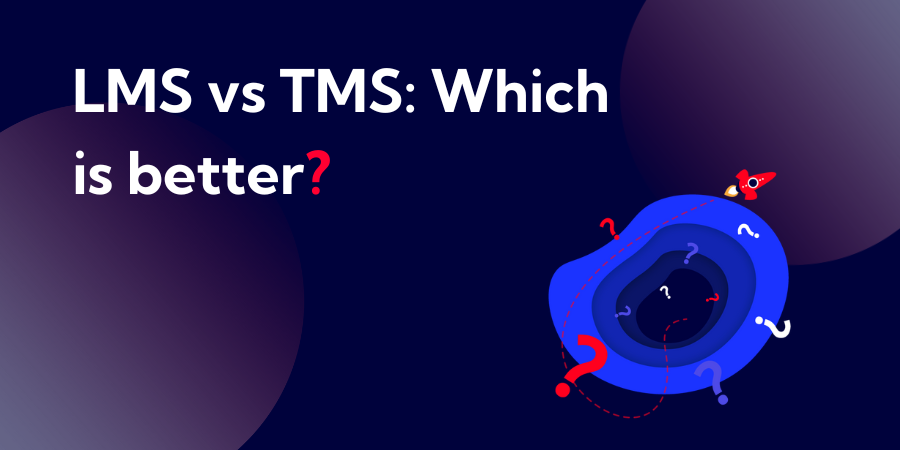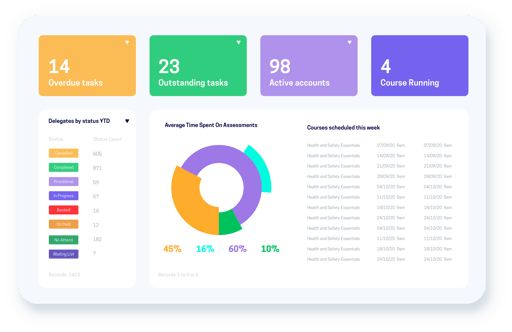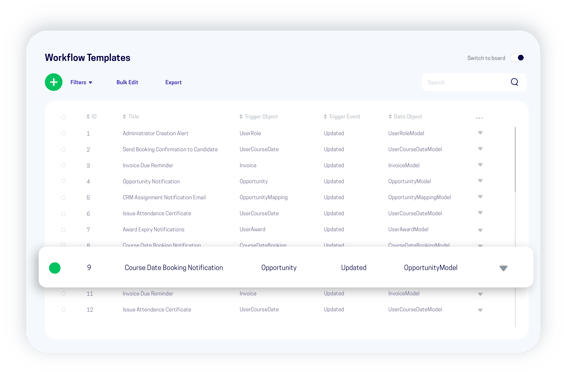LMS vs TMS: Which is better?

Which is better – a TMS or LMS? What’s the difference, and do you need both? We will answer all of these questions and more in our LMS vs TMS guide.
Both are types of software which are popular with training providers to support their processes and help them improve their training operations. However, they are different and have unique uses, and which is best will depend on your company's needs and goals. We will explore both, including their main features and benefits, and then compare them to help you find out which is best for you.
LMS vs TMS
Click below to skip directly to a section of the blog:
Do I need both an LMS and a TMS?
What is an LMS?
LMS stands for learning management system, and it is a solution designed to enable you to deliver training content online. This is ideal for creating and delivering eLearning content, such as:
- Video content
- Quizzes
- Self-paced material, like PDF downloads
This is accessible via an online environment that your delegates have their own login details for. This means that you can easily track delegate progress on your courses.
LMS functionality
Typical core functions of an LMS include:
- Course design and creation
- eLearning hosting
- Course enrolment
- Delegate communication
- Tracking training progress
- Resource libraries
- Gamification
When to choose an LMS
Using an LMS can work for both internal and external training providers, although it is more popular with internal training departments. Universities and schools often use learning management software.
If you are struggling to track learner progress on your eLearning courses, this is an ideal option to improve your reporting, as the data is recorded and stored in the LMS. You can view individual delegate progress, which can help in aiding compliance and identifying skill gaps and training requirements.
If your main training offering is self-paced online learning or blended learning, an LMS is probably well-suited to your needs. This is ideal if you are looking to cater for flexible or remote learners, or are hoping to. This is because eLearning can be accessed anywhere, meaning you can expand your market beyond your physical location.
This also means that you aren’t limited by the availability of trainers, as they can record their teaching and upload it to be watched at the leisure of the learners. So, there’s no need for them to be available at a certain time or day, eliminating some admin stress. You might not even need a trainer at all, depending on the type of content you offer.
On the other hand, using an LMS can go hand-in-hand with your face-to-face training. You might set up an online test after a classroom session to check learner understanding, for example.
What is a TMS?
So, how is a TMS different from an LMS? The answer mainly boils down to the fact that a TMS is more complex and all-encompassing, with much more features and functionality than an LMS.
A TMS, or training management system, is a piece of specialist software designed for training providers which can manage course scheduling, registrations, sales and marketing, delegate and trainer communications and much more.
Manual admin tasks such as taking course bookings, sending joining instructions and issuing certificates become a thing of the past thanks to automation. Data is stored in the platform, meaning you can instantly access records and track compliance – no need for thousands of spreadsheets.
All of the above means that a TMS helps you save time and money due to a reduced admin workload and increased efficiency, enabling you to scale your business to new heights.

TMS functionality
We’d be here for hours if we tried to list every single thing a TMS can do, but here are the main features:
- Course scheduling
- Online course booking and payment
- Organising resources such as trainers and venues
- Generating and automatically sending joining instructions, certificates, surveys and other communications
- Reporting and analytics
- Customer relationship management
- Marketing tools
- Course surveys and feedback
When to choose a TMS
If you are a training provider looking to sell your courses more effectively and centralise your operations, a TMS is one of the best investments you can make. If your admin team spends hours sending emails, trawling through spreadsheets, scheduling courses and processing bookings, a TMS can eliminate much of this pain.
They are well suited for commercial training providers that sell instructor-led courses. It can also benefit internal training departments or training arms of larger organisations.
Businesses in the education, not-for-profit or healthcare sectors, or professional development, vocational or trade skills training providers, are just some examples of industries that utilise training management software to scale up their business.
A TMS is well-suited for in-person, online and blended learning providers. Thanks to the huge range of functionalities, they are highly adaptable to your needs.

Do I need both a TMS and LMS?
So, we’ve established the differences between a TMS and LMS, but which one do you need? Or do you need both?
Some companies may benefit from having both. For example, large training companies that offer eLearning packages may find that they need both to efficiently manage all of their delegates. Often, they might begin with just an LMS and then transition to using a TMS to help scale their business.
There’s no need to get rid of your current LMS because you have realised you need a TMS - most training management systems integrate with LMS platforms for seamless transitions from one platform to another and tracking of delegate progress.
However, some training management systems like accessplanit have a built-in LMS which means there is no need to pay for disparate systems – everything can be done within one system. It's simple to upload your eLearning packages into accessplanit, and you can see this in action in this webinar:
If you do not offer eLearning, you won’t need an LMS. But with accessplanit, if you decide to diversify and want to start offering eLearning in the future, the flexibility to do so is there, without the need to source a new piece of software.
Is a TMS or LMS better?
As we’ve discussed above, which one of the two is best for your needs depends on your business and your goals.
For smaller training companies or corporate training departments that only offer eLearning and are looking to better manage learner progress and compliance, an LMS is an excellent choice.
However, for commercial training businesses looking for a solution to all of their problems in one place, an LMS alone is not going to give you the functionalities you require. A TMS is a better investment for future-proofing your company as it is a more well-rounded piece of software, designed specifically to meet the needs of training companies. If you want to grow your training company to new heights, you will struggle to do so without a TMS.
Manually managing delegate records, scheduling courses and organising resources is not an effective use of time for companies who want to scale, and a TMS cuts all of this out while offering a wide range of reporting and automation capabilities. The time that you will save, alongside the improved business visibility, will provide impressive ROI. Have a look at our case studies to see this in action.
For more details about the functionality of a TMS, check out our ultimate guide to training management software.



